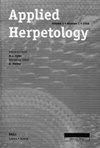Fluctuating asymmetry in Ichthyophonus -sp. infected newts, Notophthalmus viridescens , from Vermont
引用次数: 10
Abstract
Measures of fluctuating asymmetry (FA) have been used to assess the significance of stress in amphibian populations. When animals with bilateral body plans are challenged by environmental stressors, departures from bilateral symmetry can emerge during development. The tendency for FA to develop has been linked to greater susceptibility to pathogens in many organisms. In our study, newts (Notophthalmus viridescens) infected with Ichthyophonus-sp. exhibited greater size-corrected FA of the hind limbs than uninfected animals from the same population. Among infected animals, however, the intensity of infection and the extent of hind limb asymmetry were not correlated, suggesting that asymmetry did not arise following infection, but rather that newts having greater FA may have been more susceptible to infection as a result of the same stresses that produced the increase in FA. There was no relationship between dorsal spot pattern FA and infection status or hind limb FA. We suggest that spot pattern may be less canalized than hind limb development. Newts are widely distributed and important components of freshwater communities in eastern North America and, thus, any change in their vitality may affect the composition of those communities. Analyses of hind limb FA may be a useful and non-invasive tool for identifying potentially vulnerable amphibian鱼舌鱼的波动不对称性。被感染的蝾螈来自佛蒙特州
波动不对称(FA)的措施已被用来评估压力在两栖动物种群的重要性。当具有双侧身体计划的动物受到环境压力的挑战时,在发育过程中可能出现双侧对称的偏离。在许多生物体中,FA的发展趋势与对病原体的更大易感性有关。在我们的研究中,蝾螈(Notophthalmus virus下降)感染了鱼舌虫。与来自同一种群的未感染动物相比,后肢的FA尺寸校正更大。然而,在受感染的动物中,感染的强度和后肢不对称的程度并不相关,这表明不对称不是在感染后出现的,而是具有更大FA的蝾螈可能更容易受到感染,因为产生FA增加的相同压力。背斑型FA与感染状况及后肢FA无相关性。我们认为斑点模式可能比后肢发育更不受管化。蝾螈分布广泛,是北美东部淡水群落的重要组成部分,因此,它们活力的任何变化都可能影响这些群落的组成。分析后肢FA可能是一种有用的非侵入性工具,用于识别潜在的脆弱两栖动物
本文章由计算机程序翻译,如有差异,请以英文原文为准。
求助全文
约1分钟内获得全文
求助全文

 求助内容:
求助内容: 应助结果提醒方式:
应助结果提醒方式:


